Menu
Physics Lesson 9.3.1 - The Definition of Liquid Pressure
Please provide a rating, it takes seconds and helps us to keep this resource free for all to use
Welcome to our Physics lesson on The Definition of Liquid Pressure, this is the first lesson of our suite of physics lessons covering the topic of Liquid Pressure. Pascal's Principle, you can find links to the other lessons within this tutorial and access additional physics learning resources below this lesson.
The Definition of Liquid Pressure
By definition (and as indicated by the name), liquid pressure is the pressure exerted by liquids on all objects immersed in them.
Obviously, the unit of liquid pressure is Pascal [Pa].
We can still use the equation
to calculate the liquid pressure as we did for solid pressure in the previous tutorial. However, giving that the lower base of containers is not always regular, we can look for any alternative formula in order to ease the calculation of liquid pressure. For this, let's consider the following situation.
Suppose you have a rectangular container in the form of a cuboid and you have poured some liquid in it. Then, you put inside the liquid a heavy plate with negligible height. Obviously, the plate will sink and it will rest at bottom of container as shown in the figure below.
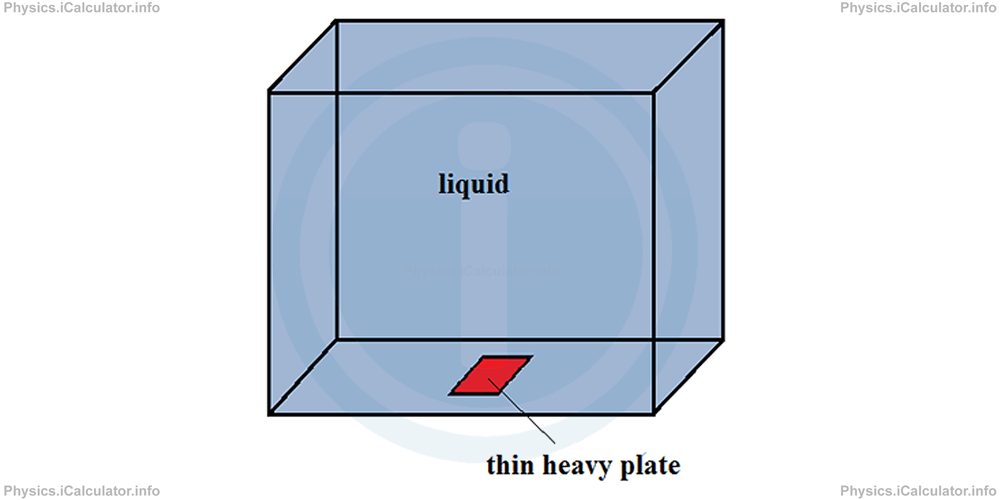
From the definition of pressure, it is obvious that only the liquid column above the plate exerts a downward force on it, due to gravity. Therefore, we must consider only the liquid column that lies above the plate, which forms a small cuboid of base A (equal to the plate's area) and height h (equal to the liquid's depth), as shown below.
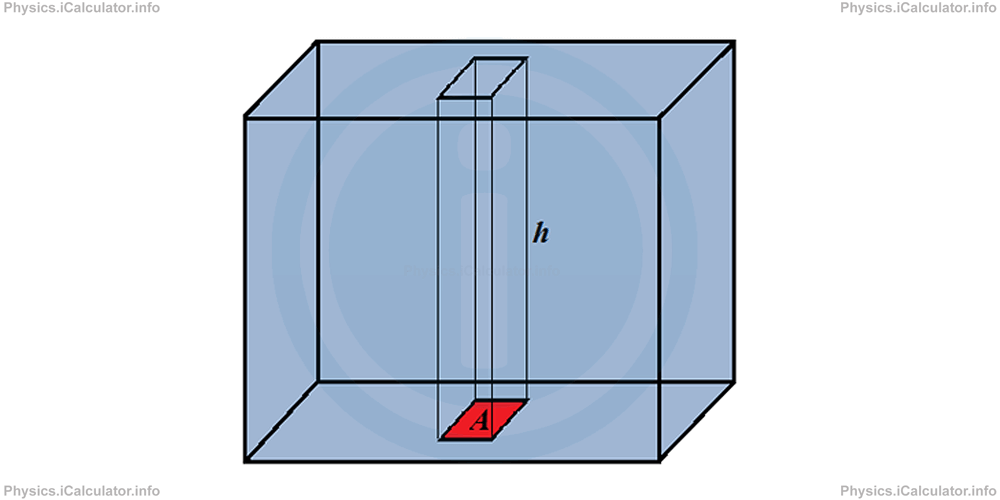
Thus, the force exerted on the plate is equal to the weight of the liquid column. From the equation of pressure
we obtain for the liquid pressure
= Wliquid/Aplate
= mliquid × g/Abase of liquid column
= ρliquid × Vliquid × g/Abase of liquid column
= ρliquid × Abase of liquid column × hliquid × g/Abase of liquid column
= ρliquid × hliquid × g
In this way, we obtained an alternative formula for liquid's pressure
besides the standard formula
we knew before.
The new formula of liquid pressure, offers great advantages compared to the standard one. Some of them include:
- No area is involved in the calculations. This means we don't have to remember all geometric formulae for area of figures or to find the area of irregular shapes by integration.
- The shape of container is not important for the same reason.
- It is not necessary to find the weight of liquid. This advantage is especially important when dealing with objects immersed in seawater as we don't need to calculate the mass of the entire seawater.
- It is enough if we know the density of liquid and the depth of the immersed object from the surface to calculate the liquid's pressure. Hence, it is enough a small sample of liquid to calculate its density experimentally. As for the liquid's depth, we can use sensors that use sound echo to calculate it.
In this way, we obtain an important property of liquid pressure:
"Liquid's pressure depends only by depth if the density of liquid is known."
In other words, liquid pressure is the same everywhere at a certain depth, regardless its position within the container, as shown in the figure below. 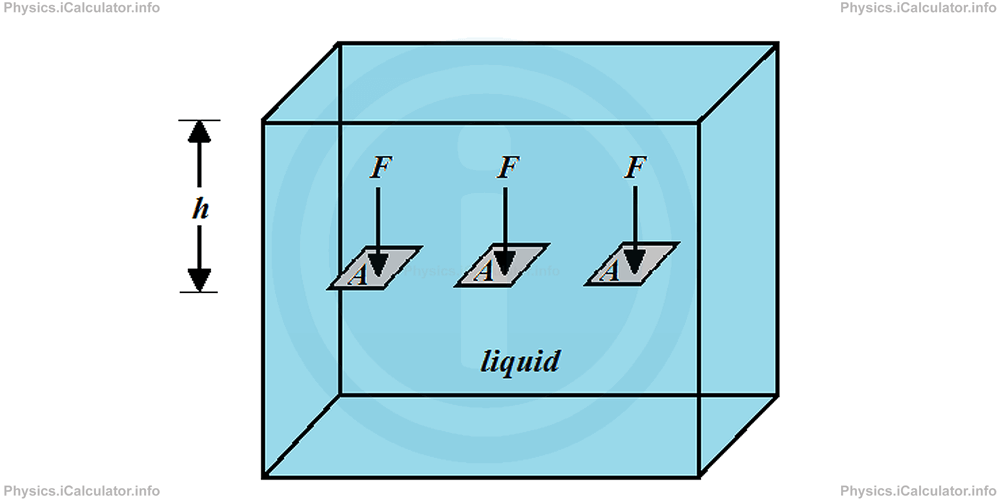
Remarks!
- The quantity h in the formula Pliquid = ρliquid × g × h shows the depth from the surface, not the height from the ground as in Kinematics. The shape and size of the base area do not affect the magnitude of liquid pressure as long as the depth is the same. Look at the figure below.
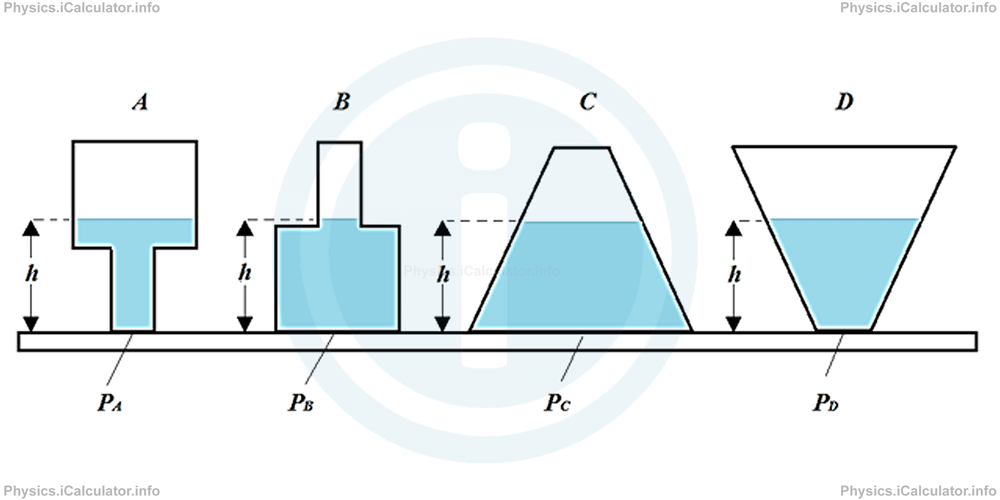
If the liquid in all four containers is the same, we have PA = PB = PC = PD for the pressure at the bottom of each container, because the height of liquid is the same in all containers.
Example 1
A swimming pool filled with water has three levels as shown in the figure below.
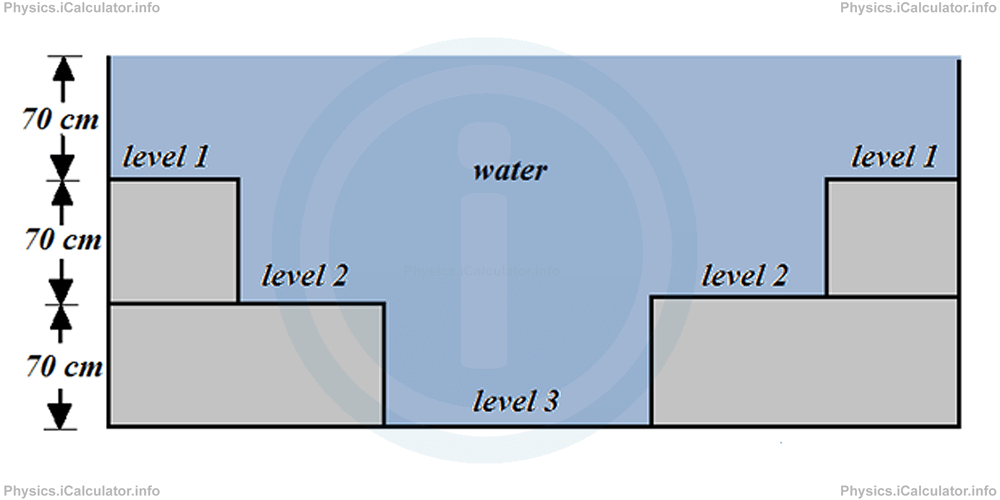
A girl who is bathing in this pool wears a watch which can hold up to 150 000 Pa more than the normal air pressure. Which level/s of the pool she can use without taking off her watch? Take g = 9.81 m/s2 and ρwater = 1000 kg/m3.
Solution 1
We must calculate which depth does a 150 000 Pa water pressure correspond. Thus, from the equation of liquid pressure
we work out the maximum depth the watch can hold. Thus,
= 150 000 Pa/1000 kg/m3 × 9.81 m/s2
= 1.53 m
= 153 cm
This means the girl can use the first level of the pool (70 cm), the second level (70 cm + 70 cm = 140 cm) but not the third level as it is 70 cm + 70 cm + 70 cm = 210 cm > 153 cm deep, because if she puts her hand at bottom of the third level, her watch may be damaged.
The same thing occurs when we immerse our body in water. We feel a slight pain on the chest due to the additional pressure exerted by water on our body. Thus, water pressure causes a pushing force throughout the surface of our body. As a result, when we breathe, we feel some pain, especially in the first day of swimming season.
Remark! Water pressure is otherwise known as "gauge pressure" as we often use a pressure gauge to measure it.
We can use the formula of liquid pressure to calculate the density of an unknown liquid by using a U-shaped tube as shown in the figure below.
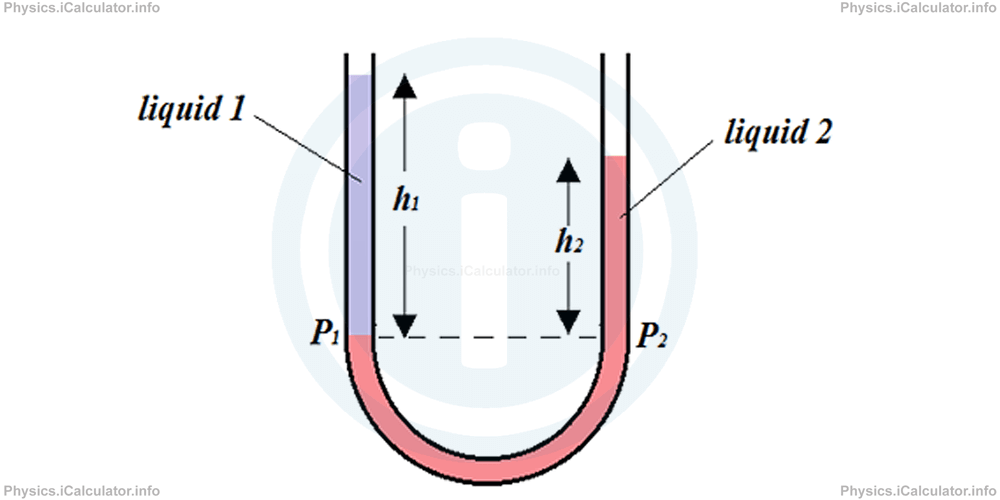
First, we pour a known liquid in the tube (liquid 2) and then, an unknown liquid above it (liquid 1). Obviously, this method works for liquids that do not mix with each other. At the position where the two liquid meet, there is the same pressure in both sides (P1 = P2). This means the pressure above this level in both sides of the tube is equal as well. Using the equation of liquid pressure, we can write
ρ1 × g × h1 = ρ2 × g × h2
where ρ1 and ρ2 are the densities of liquid 1 and 2 respectively, h1 and h2 are their heights above the meeting level and g is the gravity.
Simplifying g from both sides, we obtain
Thus, we can write for the density of the unknown liquid ρ1
Example 2
What is the density of the unknown liquid in the U-shaped tube shown in the figure below if the other liquid is mercury? Take the density of mercury equal to 13.6 g/cm3.
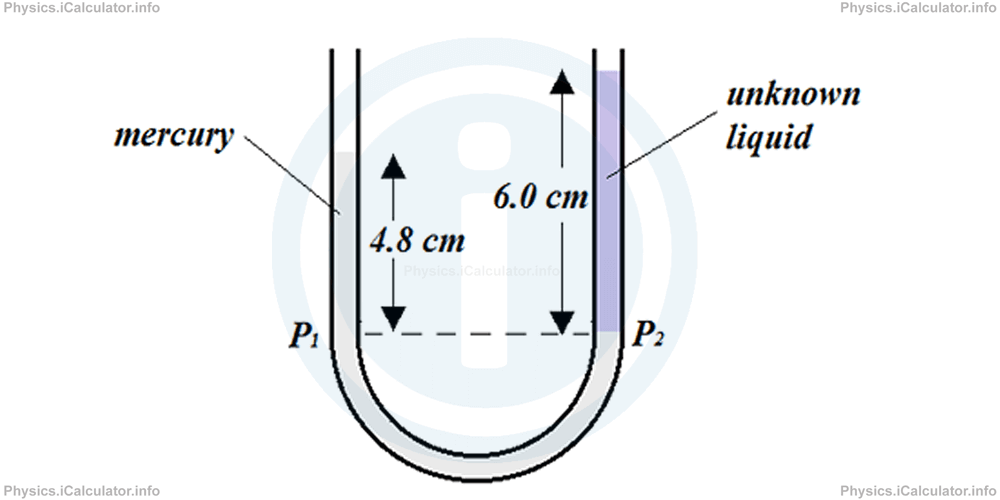
Solution 2
We have the following clues in this problem:
ρ1 = 13.6 g/cm3
h1 = 4.8 cm
h2 = 6.0 cm
ρ2 = ?
Thus, applying the equation
we obtain for the density of the unknown liquid, ρ2:
= 13.6 g/cm3 × 4.8 cm/6.0 cm
= 10.88 g/cm3
You have reached the end of Physics lesson 9.3.1 The Definition of Liquid Pressure. There are 2 lessons in this physics tutorial covering Liquid Pressure. Pascal's Principle, you can access all the lessons from this tutorial below.
More Liquid Pressure. Pascal's Principle Lessons and Learning Resources
Whats next?
Enjoy the "The Definition of Liquid Pressure" physics lesson? People who liked the "Liquid Pressure. Pascal's Principle lesson found the following resources useful:
- Definition Feedback. Helps other - Leave a rating for this definition (see below)
- Density and Pressure Physics tutorial: Liquid Pressure. Pascal's Principle. Read the Liquid Pressure. Pascal's Principle physics tutorial and build your physics knowledge of Density and Pressure
- Density and Pressure Revision Notes: Liquid Pressure. Pascal's Principle. Print the notes so you can revise the key points covered in the physics tutorial for Liquid Pressure. Pascal's Principle
- Density and Pressure Practice Questions: Liquid Pressure. Pascal's Principle. Test and improve your knowledge of Liquid Pressure. Pascal's Principle with example questins and answers
- Check your calculations for Density and Pressure questions with our excellent Density and Pressure calculators which contain full equations and calculations clearly displayed line by line. See the Density and Pressure Calculators by iCalculator™ below.
- Continuing learning density and pressure - read our next physics tutorial: Gas Pressure
Help others Learning Physics just like you
Please provide a rating, it takes seconds and helps us to keep this resource free for all to use
We hope you found this Physics lesson "Liquid Pressure. Pascal's Principle" useful. If you did it would be great if you could spare the time to rate this physics lesson (simply click on the number of stars that match your assessment of this physics learning aide) and/or share on social media, this helps us identify popular tutorials and calculators and expand our free learning resources to support our users around the world have free access to expand their knowledge of physics and other disciplines.